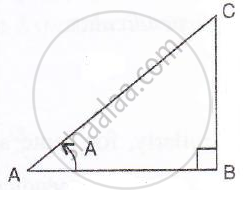Advertisements
Advertisements
प्रश्न
If sec A = `sqrt2` , find : `(3cot^2 "A"+ 2 sin^2 "A")/ (tan^2 "A" – cos ^2 "A")`.
उत्तर
Consider the figure :

sec A = `sqrt2/1`
i.e.`"hypotenuse"/"base" = "AC"/"AB" = sqrt2/1`
Therefore if length of base = x , length of hypotenuse = `sqrt2x`
Since
AB2 + BC2 = AC2 ...[Using Pythagoras Theorem]
`(sqrt2x)^2 – (x)^2 = "BC"^2`
`"BC"^2 = 2x^2 - x^2`
BC2 = x2
∴ BC = x
Now
cos A = `1/(sec "A") = 1/(sqrt2)`
sin A = `"BC"/"AC" = 1/(sqrt2)`
tan A = `"BC"/"AB"` = 1
cot A = `1/ tan "A"` = 1
Therefore
`(3cot^2 "A"+ 2 sin^2 "A")/ (tan^2 "A" – cos ^2 "A") = (3(1)^2 + 2 (1/sqrt2)^2)/ (1^2 – ( 1/sqrt2)^2)`
= `(3 + 1)/(1– (1)/(2)`
`= 4/(1/2)`
`= 4 xx 2/1`
= 8
APPEARS IN
संबंधित प्रश्न
If 3 cot A = 4, Check whether `((1-tan^2 A)/(1+tan^2 A)) = cos^2 "A" - sin^2 "A"` or not.
If A and B are acute angles such that tan A = 1/2, tan B = 1/3 and tan (A + B) = `(tan A + tan B)/(1- tan A tan B)` A + B = ?
If cot θ = `3/4` , show that `sqrt("sec θ - cosecθ"/"secθ + cosecθ" ) = 1/ sqrt(7)`
Evaluate:
cos600 cos300− sin600 sin300
sin20° = cos ______°
Given: sin θ = `p/q`.
Find cos θ + sin θ in terms of p and q.
If tan x = `1(1)/(3)`, find the value of : 4 sin2x - 3 cos2x + 2
In ΔABC, ∠A = 90°. If AB = 5 units and AC = 12 units, find: tan B.
In an isosceles triangle ABC, AB = BC = 6 cm and ∠B = 90°. Find the values of cosec C
From the given figure, find the values of cos C
